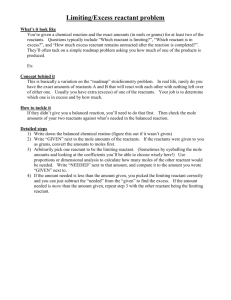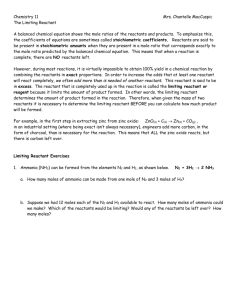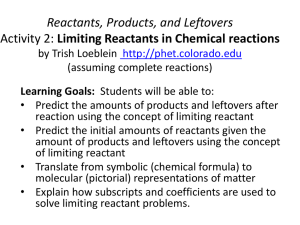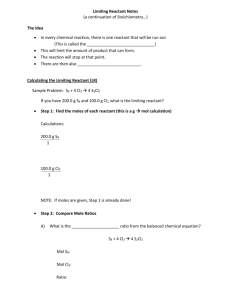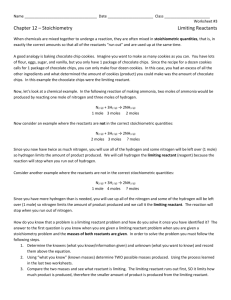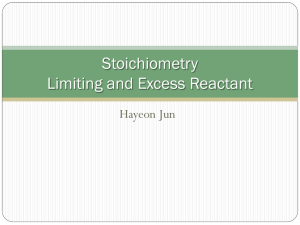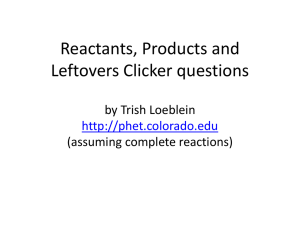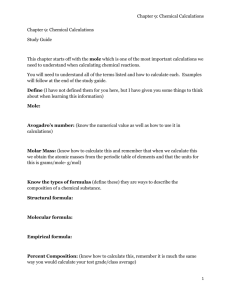The BCA Method in Stoichiometry
advertisement
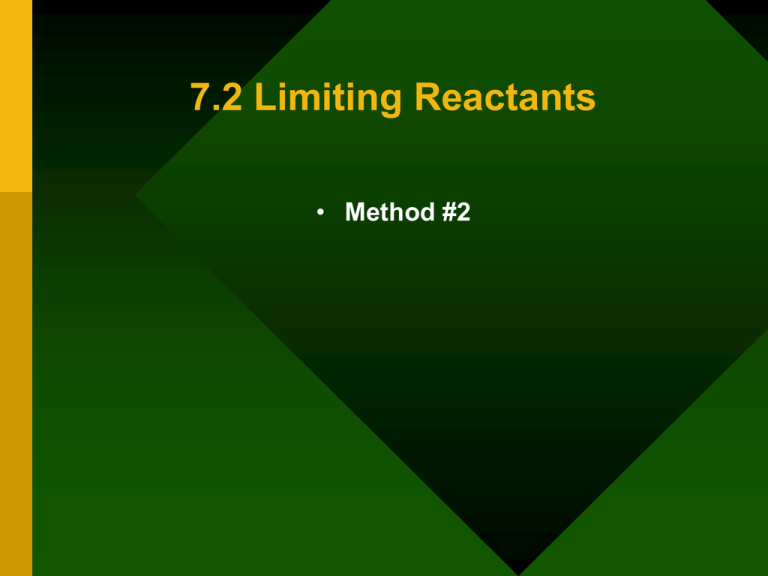
7.2 Limiting Reactants • Method #2 The SCE Method in Stoichiometry Typical Approach to Stoichiometry • Very algorithmic – grams A moles A moles B grams B – Fosters “plug-n-chug” solution • Somewhat disconnected from balanced equation • Especially poor for limiting reactant problems SCE Approach • Stresses mole relationships based on coefficients in balanced chemical equation • S = Start; C = Change; E = End. • Sets up for equilibrium calculations later (ICE tables – Grade 12) • Shows limiting reactants more clearly Only moles go in the SCE table • The balanced equation deals with how many, not how much. • If given mass of reactants, convert to moles first, then use the table. Limiting reactant problems • SCE approach distinguishes between what you start with and what reacts. • When 0.43 mole of aluminum reacts with 0.69 mole of iodine to form aluminum iodide, how many moles of the excess reactant will remain? How many moles of aluminum iodide will be formed? 2 Al Start: + 3 I2 2 AlI3 Change: End: • Always check that you have a balanced chemical equation Limiting reactant problems • Fill in the Start line with the information you know. • Divide the moles at the Start with their corresponding coefficient. • When 0.43 mole of aluminum reacts with 0.69 mole of iodine to form aluminum iodide, how many moles of the excess reactant will remain? How many moles of aluminum iodide will be formed? 2 Al Start: 0.43 + 3 I2 0.69 2 AlI3 0 Change: End: • Remember the smallest value is the one that is the limiting reactant. 0.43 = 0.215 2 0.69 3 = 0.23 Limiting reactant problems • Even if you pick the wrong one of the reactants, you can still perform the calculations. You will, however, find that an error will appear. 2 Al Start: Change: End: + 3 I2 0.43 0.69 -2(0.23) -3(0.23) 2 AlI3 0 +2(0.23) Limiting reactant problems • Even if you pick the wrong one of the reactants, you can still perform the calculations. You will, however, find that an error will appear. 2 Al Start: 0.43 + 3 I2 2 AlI3 0.69 0 Change: -0.46 -0.69 +0.46 End: error 0 0.46 • It is clear that there’s not enough Al to react with all the I2. The Change (amount needed) is greater than the Start (the amount available); Al is, therefore, the limiting reactant. Limiting reactant problems • Since Al is the limiting reactant, we must use its value to determine the single mole factor to use. 2 Al + 3 I2 Start: 0.43 0.69 Change: -2(0.215) -3(0.215) 2 AlI3 0 +2(0.215) End: • Divide the moles given by the coefficient. 0.43 2 = 0.215 Limiting reactant problems • Since Al is the limiting reactant, we must use its value to determine the single mole factor to use. 2 Al + 3 I2 2 AlI3 Start: 0.43 0.69 0 Change: -0.43 -0.645 +0.43 0 0.045 0.43 End: • When you subtract the Change from the Start, you can see that all the Al is used up, there is some I2 remaining and 0.43 moles of AlI3 is produced. SCE - a versatile tool • It doesn’t matter what the units are of the initial quantities • Convert to moles, then use the SCE table • Solve for how many, then for how much
